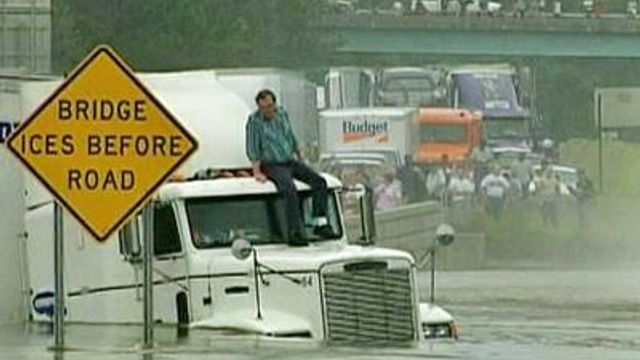Memories of Floyd still fresh for many
Hurricane Floyd hit North Carolina's coast Sept. 16, 1999, causing unexpected and unprecedented damage and leaving an impact on people and places that will last for decades.
Posted — UpdatedHurricane Katrina made landfall in Louisiana in August 2005, causing severe destruction along the Gulf Coast. Hundreds of people lost their lives in the resulting storm surge, making the storm one of the deadliest and costliest hurricanes in U.S. history.
Four years later, thousands of residents remain displaced and portions of the coast are still under reconstruction. Lessons are still being learned.
For the residents of eastern North Carolina, Hurricane Floyd was their Katrina.
The Category 2 storm made landfall in Cape Fear, N.C. on Sept. 16, 1999 – days after another storm dropped up to 16 inches of rain across the eastern part of the state. The additional 12 to 20 inches of rain from Floyd overflowed riverbanks, causing floodwaters to cover roads and inundate entire communities.
The storm left a lasting impact that still haunts flood victims today.
"The long-term psychological impact of a flood is still prevalent here," Rocky Mount Fire Chief Keith Harris said Wednesday. "I don't know if you will ever fully recover."
The Tar River, which runs by Rocky Mount, crested the day after Floyd's landfall at 33 feet – 18 feet above flood stage – putting 25 percent of the city under water. More than 500 people had to be rescued from trees, cars and homes.
Harris led many of the rescue efforts.
"Ten years later, it's still vivid," he said. "I can still see people on rooftops. I saw cases where even roofs were under water, and the last safe refuge people had was actually standing on the chimney."
When all was said and done, 52 people in North Carolina died from the Floyd – most of whom drowned as they tried to flee to higher ground.
The floods destroyed more than 8,000 homes, damaged an additional 67,000 and caused more than $6 million in property damage. The Federal Emergency Management Agency declared 66 counties natural disaster areas.
For many of the affected areas, recovery has been slow, but in the years since Floyd, many communities have made great strides.
"We have all our houses back," Princeville Mayor Delia Perkins said. "Our citizens are back. We have a new town hall."
Flooding lasted for more than a week in Princeville, damaging or destroying more than 700 homes.
Lessons learned
For Rocky Mount Mayor David Combs, the greatest lesson learned from Floyd was not to take anything for granted.
"Communities across our state that are prone to any type of natural disaster have to have a plan in place so that this type of devastation, when it occurs, you're prepared for it – not only advanced planning but the next steps after it occurs," he said.
Floyd exposed many weaknesses in the state when it came to emergency management.
About 80 percent of the North Carolina homes damaged or destroyed were not accurately depicted in a flood zone. In 1999, the flood maps were 10 to 15 years out of date.
"Many people had been building homes in flooded areas without understanding the risks," said John Dorman, director of the North Carolina Flood Mapping Program.
New technology has since been used to update the maps, which has led to the relocation of 39 hog farms and more than 90 waste lagoons, which means they won't flood again and dump nutrient pollution into waterways.
Floyd also revealed a communications problem, which led to a statewide radio network that now allows local, state and federal response agencies seamless communication with one another.
A new evacuation plan and more shelters are also in place, including special programs to rescue, feed and shelter pets.
"Pets are important," said Mark Brown with the North Carolina Division of Emergency Management. "People will not evacuate from their homes if they don't have a place to take their pets."
Floyd's devastation has also prompted Triangle researchers to make strides in better understanding how hurricanes form, move and work to cause floods.
As it approached the Atlantic Coast, the storm had weakened from a Category 4 storm but forecasters didn't anticipate the amount of rain that would fall ahead of the storm.
"Hurricanes are very complicated, because they involve small-scale convection interacting with the larger scale and becoming organized in a complicated way that's still not fully understood," said Gary Lackmann, a meteorology professor at North Carolina State University.
Using supercomputers and forecast models, Lackmann and his associates from Renaissance Computing Institute, the Army Corps of Engineers and the state of North Carolina are studying ways that hurricanes can cause floods.
"The extra horsepower means they can make higher-resolution predictions of storm surge and dangerous inland flooding, like we saw with Floyd," he said.
That leads to better planning and better preparedness.
For flood victims, that hopefully means devastation on a less proportional scale when the next Floyd hits.
"It was an absolute shock, We had hundreds, maybe thousands of people who needed help," former Rocky Mount Mayor Fred Turnage said of Floyd.
"We had never experienced anything of this magnitude. Our response was amazingly good considering how unprepared we might have been."
Copyright 2024 by Capitol Broadcasting Company. All rights reserved. This material may not be published, broadcast, rewritten or redistributed.






